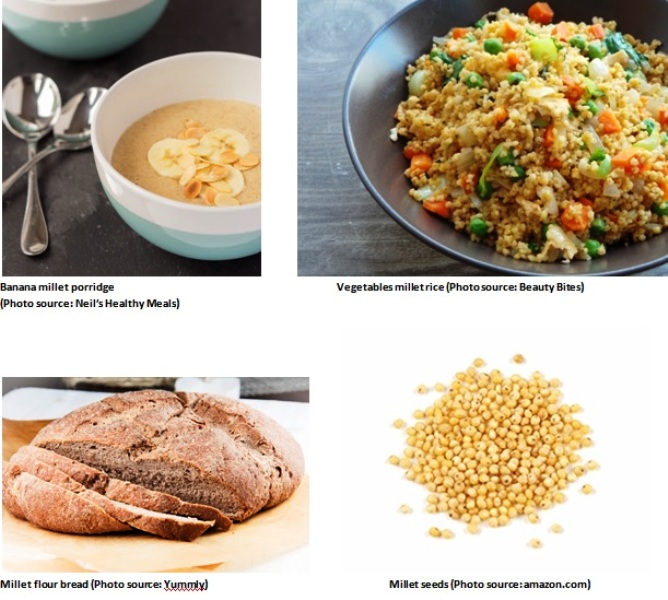Millets – Nutritional properties and recipe ideas |20 July 2018
Earlier this week, local supermarket ‘Chez Deenu’ in Victoria began selling more than 18 varieties of millet, imported from India.
Millet is a fairly new ingredient in Seychelles. For this reason, Earthy Goodness, a blog run by a Seychellois, which talks about  the natural goodness stemming from the earth for various nutrition and wellness purposes, as well as healthy baking topics, shares findings about millet, its nutritional values, and how it can be incorporated into our meals.
the natural goodness stemming from the earth for various nutrition and wellness purposes, as well as healthy baking topics, shares findings about millet, its nutritional values, and how it can be incorporated into our meals.
Millet has been among important staples in the semi-arid tropics of Asia and Africa for centuries. Today, this small, yellow seed ranks as the sixth most important grain in the world, and is becoming a more commonly consumed ingredient in the Western part of the world.
Millets are gluten-free whole-grains and contain a number of nutrients essential for our health; this includes:
- Vegetarian protein
- Vitamins and minerals
- Antioxidants
- Fibre
The seeds are rich in phytochemicals, including Phytic acid, which is believed to lower cholesterol, and Phytate, which is associated with reduced cancer risk.
According to an article of ‘Frontiers in Plant Science’ journal, there is evidence to support that millet has properties which make it a good dietary option for diabetics. The tests conducted on diabetic mice concluded that added millet protein can increase insulin sensitivities, and reduce blood glucose level, as well as triglyceride level.
Millet is not an acid forming food so it is soothing and easy to digest. It is considered to be one of the least allergenic and most digestible grains available.
Being a whole-grain, millet is not refined during processing, meaning that similarly to other whole-grains, it retains a lot more of its nutrients which are beneficial to our health.
Millets have a nutty flavour and because they are versatile, they are used in diverse ways, such as in soups, stews, casseroles and baked goods. They can also be used as an alternative to various other starchy ingredients like cereals, oatmeal, rice and pasta.
For those who will be trying out millets, Earthy Goodness proposes a few simple, healthy and innovative recipes which take into account some common dishes eaten by our locals, and which although are uncommon in our culture, may help to bring some diversity to our meals and diets.
Millet Porridge by Delicious as it Looks
- Combine 2/3 cup of millet, 2 cups of low-fat milk, 1 ½ cups water and a pinch of salt in a large pot.
- Bring to a boil, reduce heat, cover and simmer for about 25 minutes without stirring.
- Continue to cook partially covered until desired consistency.
- Top with or add in local fruits, spices and natural sweeteners like banana, turmeric, cinnamon, local honey and vanilla.
Vegetable millet ‘rice’ by Beauty Bites
*Millet can be cooked like rice using 3 parts water and 1 part grain. For this recipe, use 1 cup raw millet to yield about 3 ½ cups cooked millet.
- Add grains to boiling water; simmer covered for approximately 30 minutes or until the water is completely absorbed; remove from heat and let steam, covered for ten minutes more.
- While cooking the millet, chop your favourite vegetables, including onions and garlic.
- Once the millet is cooked, scramble 3 or 4 eggs in a large pan at medium-high heat with some olive oil.
- When eggs are ready, add onions and garlic and stir; add the cooked millet and stir again.
- Add 1 tablespoon olive oil and salt/pepper according to taste; add chopped vegetables, stir, turn off heat and continue stirring for a few minutes before serving.
Millet bread by Virtuous Bread
Ingredients
- 300 grams wholemeal flour
- 200 grams millet flour
- 800-900 grams water
- 3 grams dry yeast (1.5 grams instant yeast or 6 grams fresh yeast)
- 10 g salt
Instructions
- Proof the yeast in the usual way and add in the flours.
- Pour in the water and knead for 15 minutes or so, and then let rest for 1 hour.
- Shape and let rest for 45 minutes.
- Bake at 200 degrees C for 45 minutes.

(The content of this article is for general information purposes only, and should not be used as a replacement for any medical advice of your doctor/other health care professional.)
References: Food and Agriculture Organisation of the United Nations; Frontiers in Plant Science journal (National Center for Biotechnology Information); Chet Day’s (Colorado Department of Agriculture); Livestrong




